|
Table of Contents |
|
Moons of Mars |
|
Deimos,
Phobos |
|
Historical Books |
|
|
|
Mars Resources |

PASADENA, Calif. -- Observations from NASA's Mars Reconnaissance Orbiter have revealed possible flowing water during the warmest months on Mars.
"NASA's Mars Exploration Program keeps bringing us closer to determining whether the Red Planet could harbor life in some form," NASA Administrator Charles Bolden said, "and it reaffirms Mars as an important future destination for human exploration."
Dark, finger-like features appear and extend down some Martian slopes during late spring through summer, fade in winter, and return during the next spring. Repeated observations have tracked the seasonal changes in these recurring features on several steep slopes in the middle latitudes of Mars' southern hemisphere.
"The best explanation for these observations so far is the flow of briny water," said Alfred McEwen of the University of Arizona, Tucson. McEwen is the principal investigator for the orbiter's High Resolution Imaging Science Experiment (HiRISE) and lead author of a report about the recurring flows published in Thursday's edition of the journal Science.
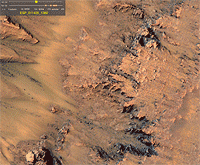 |
| This series of images shows warm-season features that might be evidence of salty liquid water active on Mars today. Image credit: NASA/JPL-Caltech/Univ. of Arizona. Full image and caption |
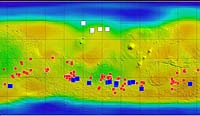 |
| This map of Mars shows relative locations of three types of findings related to salt or frozen water, plus a new type of finding that may be related to both salt and water. Image Credit: NASA/JPL-Caltech/ASU/UA/LANL/MSSS. Full image and caption |
"These dark lineations are different from other types of features on Martian slopes," said Mars Reconnaissance Orbiter Project Scientist Richard Zurek of NASA's Jet Propulsion Laboratory in Pasadena, Calif. "Repeated observations show they extend ever farther downhill with time during the warm season."
The features imaged are only about 0.5 to 5 yards or meters wide, with lengths up to hundreds of yards. The width is much narrower than previously reported gullies on Martian slopes. However, some of those locations display more than 1,000 individual flows. Also, while gullies are abundant on cold, pole-facing slopes, these dark flows are on warmer, equator-facing slopes.
The images show flows lengthen and darken on rocky equator-facing slopes from late spring to early fall. The seasonality, latitude distribution and brightness changes suggest a volatile material is involved, but there is no direct detection of one. The settings are too warm for carbon-dioxide frost and, at some sites, too cold for pure water. This suggests the action of brines, which have lower freezing points. Salt deposits over much of Mars indicate brines were abundant in Mars' past. These recent observations suggest brines still may form near the surface today in limited times and places.
When researchers checked flow-marked slopes with the orbiter's Compact Reconnaissance Imaging Spectrometer for Mars (CRISM), no sign of water appeared. The features may quickly dry on the surface or could be shallow subsurface flows.
"The flows are not dark because of being wet," McEwen said. "They are dark for some other reason."
A flow initiated by briny water could rearrange grains or change surface roughness in a way that darkens the appearance. How the features brighten again when temperatures drop is harder to explain.
"It's a mystery now, but I think it's a solvable mystery with further observations and laboratory experiments," McEwen said.
These results are the closest scientists have come to finding evidence of liquid water on the planet's surface today. Frozen water, however has been detected near the surface in many middle to high-latitude regions. Fresh-looking gullies suggest slope movements in geologically recent times, perhaps aided by water. Purported droplets of brine also appeared on struts of the Phoenix Mars Lander. If further study of the recurring dark flows supports evidence of brines, these could be the first known Martian locations with liquid water.
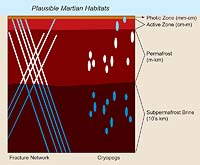 Plausible Martian Habitats
Plausible Martian Habitats
Unfrozen brine in cryopegs and fracture networks provides habitats for the survival and growth of organisms both within and under frozen rocky materials on Earth and, by analogy, could provide habitats on Mars. Cryopegs are isolated lenses or pockets of highly saline, liquid water that is permanently subzero (Celsius) in temperature due to chilling by the surrounding permafrost.
The search for unfrozen Martian niches has expanded with the discovery of seasonally recurring linear features on slopes which might or might not be associated with cryopegs.
On this graphic, mm-cm refers to depths below the ground surface of millimeters to centimeters in vertical scale (fractions of an inch); cm-m refers to depths of centimeters to meters scale (half an inch to several yards); m-km refers to depths of meters to kilometers scale (a yard to a few miles); and 10's km refers to depth of tens of kilometers (several miles or more).
(Courtesy NASA/Indiana University)
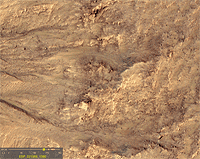 Warm-Season Flows on Slope in Newton Crater (Five-Image Sequence)
Warm-Season Flows on Slope in Newton Crater (Five-Image Sequence)
This series of images shows warm-season features that might be evidence of salty liquid water active on Mars today. Evidence for that possible interpretation is presented in a report by McEwen et al. in the Aug. 5, 2011, edition of Science.
The features that extend down the slope during warm seasons are called recurring slope lineae. They are narrow (one-half to five yards or meters wide), relatively dark markings on steep (25 to 40 degree) slopes at several southern hemisphere locations. Repeat imaging by HiRISE shows the features appear and incrementally grow during warm seasons and fade in cold seasons. They extend downslope from bedrock outcrops, often associated with small channels, and hundreds of them form in rare locations. They appear and lengthen in the southern spring and summer from 48 degrees to 32 degrees south latitudes favoring equator-facing slopes. These times and places have peak surface temperatures from about 10 degrees below zero Fahrenheit to 80 degree above zero Fahrenheit (about 250 to 300 Kelvin). Liquid brines near the surface might explain this activity, but the exact mechanism and source of the water are not understood.
(Courtesy NASA/JPL-Caltech/Univ. of Arizona)
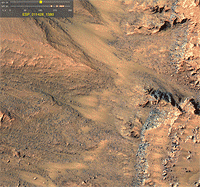 Dark Flows in Newton Crater Extending During Summer (Six-Image Sequence)
Dark Flows in Newton Crater Extending During Summer (Six-Image Sequence)
This series of images shows warm-season features that might be evidence of salty liquid water active on Mars today. Evidence for that possible interpretation is presented in a report by McEwen et al. in the Aug. 5, 2011, edition of Science.
These images come from observations of Newton crater, at 41.6 degrees south latitude, 202.3 degrees east longitude, by the High Resolution Imaging Science Experiment (HiRISE) camera on NASA's Mars Reconnaissance Orbiter. In time, the series spans from early spring of one Mars year to mid-summer of the following year. The images taken from oblique angles have been adjusted so that all steps in the sequence show the scene as if viewed from directly overhead.
The features that extend down the slope during warm seasons are called recurring slope lineae. They are narrow (one-half to five yards or meters wide), relatively dark markings on steep (25 to 40 degree) slopes at several southern hemisphere locations. Repeat imaging by HiRISE shows the features appear and incrementally grow during warm seasons and fade in cold seasons. They extend downslope from bedrock outcrops, often associated with small channels, and hundreds of them form in rare locations. They appear and lengthen in the southern spring and summer from 48 degrees to 32 degrees south latitudes favoring equator-facing slopes. These times and places have peak surface temperatures from about 10 degrees below zero Fahrenheit to 80 degree above zero Fahrenheit (about 250 to 300 Kelvin). Liquid brines near the surface might explain this activity, but the exact mechanism and source of the water are not understood.
The series is timed to dwell two seconds on the first and last frames and one second on intermediate frames, though network or computer performance may cause this to vary.
(Courtesy NASA/JPL-Caltech/Univ. of Arizona)
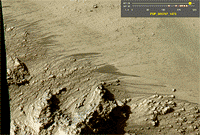 Warm-Season Flows on Slope in Horowitz Crater (Eight-Image Sequence)
Warm-Season Flows on Slope in Horowitz Crater (Eight-Image Sequence)
This series of images shows warm-season features that might be evidence of salty liquid water active on Mars today. Evidence for that possible interpretation is presented in a report by McEwen et al. in the Aug. 5, 2011, edition of Science.
These images come from observations of Horowitz crater, at 32 degrees south latitude, 141 degrees east longitude, by the High Resolution Imaging Science Experiment (HiRISE) camera on NASA's Mars Reconnaissance Orbiter. In time, the series spans from late summer of one Mars year to mid-summer of two years later. The images taken from oblique angles have been adjusted so that all steps in the sequence show the scene as if viewed from directly overhead.
The features that extend down the slope during warm seasons are called recurring slope lineae. They are narrow (one-half to five yards or meters wide), relatively dark markings on steep (25 to 40 degree) slopes at several southern hemisphere locations. Repeat imaging by HiRISE shows the features appear and incrementally grow during warm seasons and fade in cold seasons. They extend downslope from bedrock outcrops, often associated with small channels, and hundreds of them form in rare locations. They appear and lengthen in the southern spring and summer from 48 degrees to 32 degrees south latitudes favoring equator-facing slopes. These times and places have peak surface temperatures from about 10 degrees below zero Fahrenheit to 80 degree above zero Fahrenheit (about 250 to 300 Kelvin). Liquid brines near the surface might explain this activity, but the exact mechanism and source of the water are not understood.
(Courtesy NASA/JPL-Caltech/Univ. of Arizona)
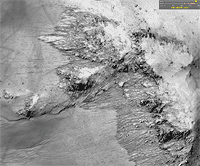 Warm-Season Flows on Slope in Horowitz Crater (Nine-Image Sequence)
Warm-Season Flows on Slope in Horowitz Crater (Nine-Image Sequence)
This series of images shows warm-season features that might be evidence of salty liquid water active on Mars today. Evidence for that possible interpretation is presented in a report by McEwen et al. in the Aug. 5, 2011, edition of Science.
These images come from observations of Horowitz crater, at 32 degrees south latitude, 141 degrees east longitude, by the High Resolution Imaging Science Experiment (HiRISE) camera on NASA's Mars Reconnaissance Orbiter. In time, the series spans from late summer of one Mars year to mid-summer of two years later. The images taken from oblique angles have been adjusted so that all steps in the sequence show the scene as if viewed from directly overhead.
The features that extend down the slope during warm seasons are called recurring slope lineae. They are narrow (one-half to five yards or meters wide), relatively dark markings on steep (25 to 40 degree) slopes at several southern hemisphere locations. Repeat imaging by HiRISE shows the features appear and incrementally grow during warm seasons and fade in cold seasons. They extend downslope from bedrock outcrops, often associated with small channels, and hundreds of them form in rare locations. They appear and lengthen in the southern spring and summer from 48 degrees to 32 degrees south latitudes favoring equator-facing slopes. These times and places have peak surface temperatures from about 10 degrees below zero Fahrenheit to 80 degree above zero Fahrenheit (about 250 to 300 Kelvin). Liquid brines near the surface might explain this activity, but the exact mechanism and source of the water are not understood.
(Courtesy NASA/JPL-Caltech/Univ. of Arizona)
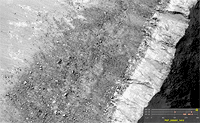 Warm-Season Flows on Steep Slope in Slope in Terra Cimmeria (Eight-Image Sequence)
Warm-Season Flows on Steep Slope in Slope in Terra Cimmeria (Eight-Image Sequence)
This series of images shows warm-season features that might be evidence of salty liquid water active on Mars today. Evidence for that possible interpretation is presented in a report by McEwen et al. in the Aug. 5, 2011, edition of Science.
These images come from observations of a steep crater slope in the Terra Cimmeria region of Mars, at 38.8 degrees south latitude, 159.5 degrees east longitude, by the High Resolution Imaging Science Experiment (HiRISE) camera on NASA's Mars Reconnaissance Orbiter. In time, the series spans from the end of summer of one Mars year to mid-summer of two years later. The images taken from oblique angles have been adjusted so that all steps in the sequence show the scene as if viewed from directly overhead.
The features that extend down the slope during warm seasons are called recurring slope lineae. They are narrow (one-half to five yards or meters wide), relatively dark markings on steep (25 to 40 degree) slopes at several southern hemisphere locations. Repeat imaging by HiRISE shows the features appear and incrementally grow during warm seasons and fade in cold seasons. They extend downslope from bedrock outcrops, often associated with small channels, and hundreds of them form in rare locations. They appear and lengthen in the southern spring and summer from 48 degrees to 32 degrees south latitudes favoring equator-facing slopes. These times and places have peak surface temperatures from about 10 degrees below zero Fahrenheit to 80 degree above zero Fahrenheit (about 250 to 300 Kelvin). Liquid brines near the surface might explain this activity, but the exact mechanism and source of the water are not understood.
(Courtesy NASA/JPL-Caltech/Univ. of Arizona)
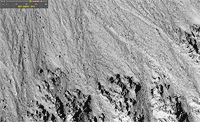 Warm-Season Flows in Well-Preserved Crater in Terra Sirenum (Six-Image Sequence)
Warm-Season Flows in Well-Preserved Crater in Terra Sirenum (Six-Image Sequence)
This series of images shows warm-season features that might be evidence of salty liquid water active on Mars today. Evidence for that possible interpretation is presented in a report by McEwen et al. in the Aug. 5, 2011, edition of Science.
These images come from observations of a well-preserved crater in the Terra Sirenum region of Mars, at 48.1 degrees south latitude, 242.4 degrees east longitude, by the High Resolution Imaging Science Experiment (HiRISE) camera on NASA's Mars Reconnaissance Orbiter. In time, the series spans from mid-spring to mid-summer within one Mars year. The images taken from oblique angles have been adjusted so that all steps in the sequence show the scene as if viewed from directly overhead.
The features that extend down the slope during warm seasons are called recurring slope lineae. They are narrow (one-half to five yards or meters wide), relatively dark markings on steep (25 to 40 degree) slopes at several southern hemisphere locations. Repeat imaging by HiRISE shows the features appear and incrementally grow during warm seasons and fade in cold seasons. They extend downslope from bedrock outcrops, often associated with small channels, and hundreds of them form in rare locations. They appear and lengthen in the southern spring and summer from 48 degrees to 32 degrees south latitudes favoring equator-facing slopes. These times and places have peak surface temperatures from about 10 degrees below zero Fahrenheit to 80 degree above zero Fahrenheit (about 250 to 300 Kelvin). Liquid brines near the surface might explain this activity, but the exact mechanism and source of the water are not understood.
(Courtesy NASA/JPL-Caltech/Univ. of Arizona)
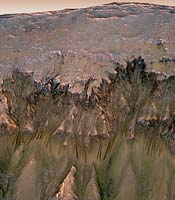 Oblique View of Warm Season Flows in Newton Crater
Oblique View of Warm Season Flows in Newton Crater
An image combining orbital imagery with 3-D modeling shows flows that appear in spring and summer on a slope inside Mars' Newton crater. Sequences of observations recording the seasonal changes at this site and a few others with similar flows might be evidence of salty liquid water active on Mars today. Evidence for that possible interpretation is presented in a report by McEwen et al. in the Aug. 5, 2011, edition of Science.
This image has been reprojected to show a view of a slope as it would be seen from a helicopter inside the crater, with a synthetic Mars-like sky. The source observation was made May 30, 2011, by the High Resolution Imaging Science Experiment (HiRISE) camera on NASA's Mars Reconnaissance Orbiter. Color has been enhanced. The season was summer at the location, 41.6 degrees south latitude, 202.3 degrees east longitude.
The flow features are narrow (one-half to five yards or meters wide), relatively dark markings on steep (25 to 40 degree) slopes at several southern hemisphere locations. Repeat imaging by HiRISE shows the features appear and incrementally grow during warm seasons and fade in cold seasons.
(Courtesy NASA/JPL-Caltech/Univ. of Arizona)

 Return to Earth
Return to Earth Voyage to Jupiter
Voyage to Jupiter